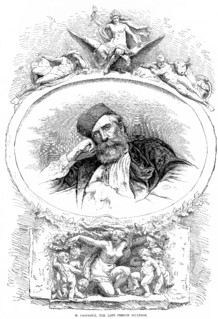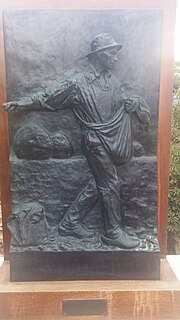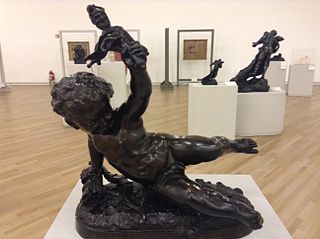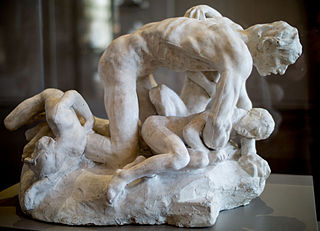
Jean-Baptiste Carpeaux was a French sculptor and painter during the Second Empire under Napoleon III.
Otto Maria Carpeaux, born Otto Karpfen, was an Austrian-born Brazilian literary critic and multilingual scholar.

José Lins do Rego Cavalcanti was a Brazilian novelist most known for his semi-autobiographical "sugarcane cycle." These novels were the basis of films that had distribution in the English speaking world. Along with Graciliano Ramos and Jorge Amado he stands as one of the greatest regionalist writers of Brazil According to Otto Maria Carpeaux, José Lins was "the last of the story tellers". His first novel, Menino de Engenho, was published with difficulty, but soon it got praised by the critics.
The Prêmio Jabuti is a well-known literary award in Brazil. It was created in 1958 by Edgard Cavalheiro.
Austrian Brazilians refers to Brazilians of full, partial, or predominantly Austrian ancestry, or Austrian-born people residing in Brazil. Brazil is home to the second largest German-Austrian population outside their respective nations, after the United States. German is the second most spoken language in the country. The author Stefan Zweig who wrote about Brazil, and the Habsburg-Lorraine Maria Leopoldina of Austria, Empress consort of Brazil, are among the most prominent Austrians to settle in Brazil.

Charles-Alphonse-Achille Guméry was a French sculptor working in an academic realist manner in Paris. Several of his figures ornament the Opéra Garnier most notoriously the group La Danse, which was commissioned from him after the group by Jean-Baptiste Carpeaux was found unacceptable.

Eugénie Fiocre was a principal dancer at the Paris Opéra 1864–75 where she often danced en travesti, creating Frantz in Coppélia in 1870, and, renowned for her beauty, was sculpted by Jean-Baptiste Carpeaux and painted by Degas in a scene from Saint-Léon's ballet La Source. She was married to Stanislas Le Compasseur de Créqui-Montfort Marquis de Courtivron and mother of explorer, anthropologist, diplomat and Olympian Georges de Crequi-Montfort.

The Fontaine de l'Observatoire is a monumental fountain located in the Jardin Marco Polo, south of the Jardin du Luxembourg in the 6th arrondissement of Paris, with sculpture by Jean-Baptiste Carpeaux. It was dedicated in 1874. It is also known as the Fontaine des Quatre-Parties-du-Monde, for the four parts of the world embodied by its female figures, or simply the Fontaine Carpeaux.

Félix-Alexandre Desruelles (1865–1943) was a French sculptor who was born in Valenciennes in 1865. He was runner up for the Prix de Rome in 1891, won the Prix national des Salons in 1897 and a Gold Medal at l'Éxposition Universelle in 1900. He died in La Flèche in 1943. He was a member of the Institut de France and of the Académie des Beaux-Arts.

George Barbu Știrbei or Știrbeiŭ, also known as Gheorghe, Georgie, or Iorgu Știrbei, was a Wallachian-born Romanian aristocrat and politician who served as the Minister of Foreign Affairs from July 15, 1866 until February 21, 1867. He was the eldest son of Barbu Dimitrie Știrbei, Prince of Wallachia, and the nephew of his rival, Gheorghe Bibescu; his younger siblings included the landowner and industrialist Alexandru B. Știrbei. Educated in France, he returned to Wallachia during his father's princely mandate, as a Beizadea and aspiring politician. Fleeing his country during the Crimean War, he served the French Empire before returning home to become Wallachian Minister of War and Spatharios. He is remembered for reforming the Wallachian militia during the remainder of Prince Barbu's term.
Ugolino and his sons may refer to:

The Negress is a bronze sculpture by French artist Jean-Baptiste Carpeaux. It is now in the permanent collection at the Indianapolis Museum of Art.The Negress was purchased by the Indianapolis Museum of Art in 1980.
Anne Middleton Wagner, often known as Anne Wagner, is an art historian. Class of 1936 Professor Emerita at the University of California, Berkeley, she is now based in London, where in 2013–14 she was Visiting Professor at the Courtauld Institute of Art.

L'Amour à la folie is an 1869 sculpture by Jean-Baptiste Carpeaux, part of the sculptural group La Danse for the Paris Opéra Garnier. The sculpture was commissioned by the building's architect Charles Garnier. The Musée d'Orsay in Paris holds a terracotta edition, the Museo Soumaya in Mexico City holds both a terracotta and a bronze and the Museu Calouste Gulbenkian in Lisbon holds an edition in marble.

La Danse is an 1868 sculpture by the French artist Jean-Baptiste Carpeaux. It was one of four sculptural groups made from Echaillon marble that decorate the façade of the Opera Garnier in Paris, two to either side of the entrance at ground level. The work was installed in 1869, and widely criticised as obscene. It was attacked in August 1869 when an anonymous vandal threw black ink over it. The scandal subsided after the outbreak of the Franco-Prussian War in 1870, and the original statue remained on the façade at the opera until it was transferred to the Louvre Museum in 1964 and replaced by a copy. The original was moved to the Musée d'Orsay in 1986.

Ugolino and his sons is a plaster sculpture by French artist Auguste Rodin, part of the sculptural group known as The Gates of Hell. As an independent piece, it was exhibited by its author in Brussels (1887), Edinburgh (1893), Genoa (1896), Florence (1897), Netherlands (1899) and in his own retrospective in 1900.

Ugolino and His Sons is a marble sculpture of Ugolino made by Jean-Baptiste Carpeaux in Paris during the 1860s. It depicts the story of Ugolino from Dante's Inferno in which the 13th century count is imprisoned and starving with his children. The work, known for its expressive detail, launched Carpeaux's career.

The musée des beaux-arts de Valenciennes is a municipal museum in the French town of Valenciennes. Its collections originated as the collection of the Académie valenciennoise de peinture et de sculpture. It opened to the public for the first time in 1801 and was moved into the town hall in 1834.

Why Born Enslaved! or Why Born a Slave? is a life-sized marble bust by the French sculptor Jean-Baptiste Carpeaux depicting a bound woman of African descent.













